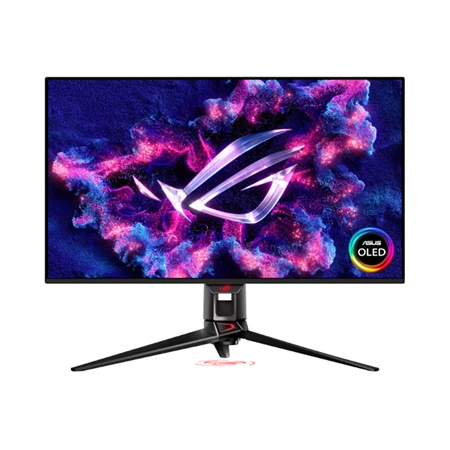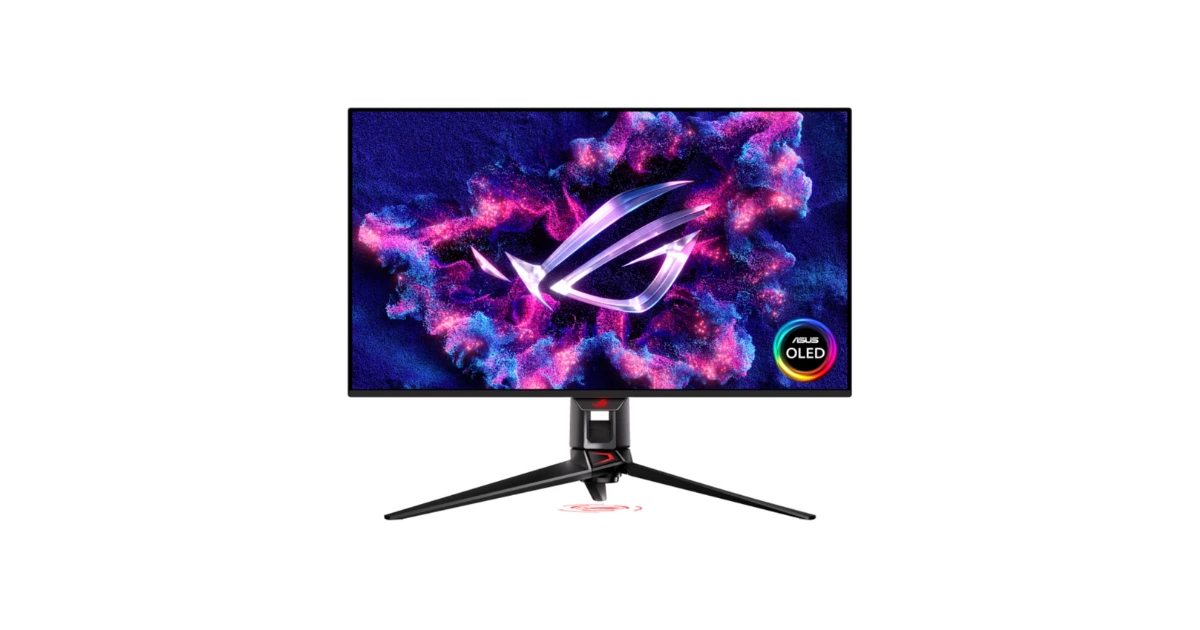
An elite 32-inch 4K OLED gaming monitor with 240Hz refresh rate, perfect for both competitive and immersive gameplay.
Buy on AmazonThe Asus ROG Swift PG32UCDP is a 32-inch flat 16:9 WOLED gaming monitor that delivers impressive performance and premium features. Unlike Quantum Dot OLED displays, this white OLED panel offers significantly higher brightness, reaching over 700 nits in HDR mode (25% window). For comparison, QD-OLED panels typically max out around 450 nits under similar conditions, giving the PG32UCDP a clear edge in HDR brightness.
Color performance is exceptional, with the panel covering nearly 100% of the DCI-P3 color space and offering an accurate sRGB mode. It’s factory-calibrated for color accuracy under 2dE, and real-world testing confirmed scores under 1dE with excellent gamma tracking. The display includes advanced brightness controls, including a constant brightness setting, and HDR mode offers fine-tuning options.
For gamers, the PG32UCDP includes the full suite of Asus GamePlus enhancements such as customizable AI crosshairs, sniper mode, FPS counter, timers, and screen alignment tools. A standout feature is Frame Rate Boost, which drops the resolution to 1920x1080 and enables a blistering 480Hz refresh rate, making it ideal for fast-paced competitive gaming. Settings can be adjusted using the intuitive OSD joystick or through Asus’ DisplayWidget Center software on Windows.
Build quality is top-tier, featuring Asus’ signature cyberpunk-inspired design with a robust mix of metal and thick plastics. The ergonomic stand provides height, tilt, swivel, and pivot adjustments, and includes a threaded mount for cameras or accessories. RGB lighting accents the rear, with a large illuminated ROG logo and a light projection feature that casts branded visuals onto the desktop.
Connectivity is extensive, including DisplayPort 1.4, HDMI 2.1, USB-C, a built-in KVM switch, three USB ports, a headphone jack, and S/PDIF optical output for high-fidelity digital audio. While it lacks internal speakers, the monitor’s outputs support seamless integration with external sound systems.
With its combination of cutting-edge specs, ultra-high refresh rate, and color precision, the PG32UCDP sets a new benchmark for OLED gaming monitors. It’s designed not only for top-tier gaming but also for creative professionals and productivity-focused users seeking elite performance.
Overview
From the front, the Asus ROG Swift PG32UCDP showcases a sleek, minimalist look, dominated by the 32-inch panel and ultra-thin flush bezels. A small, illuminated ROG logo sits at the center of the bottom edge. On the back, you’ll find the OSD joystick and two additional buttons, one for power and another for switching between 240Hz and 480Hz refresh rates. The stand base features RGB lighting around its perimeter, along with a logo projector beneath. The projector lens is magnetically attached and easily swappable. All lighting and effects are fully customizable or disableable via the on-screen display.
Around back, the large ROG logo is dotted with LED effects set into a textured panel. Despite the monitor’s high-end hardware, the component bulge is modest, just 2.8 inches deep. The panel itself is backed with metal and measures only 4mm thick. Build quality is standout across the board: the cast metal base and upright deliver excellent stability, with smooth ergonomic adjustments including 5° forward/20° backward tilt, 15° swivel, and 3.1 inches of height travel. A threaded mount on top allows for easy attachment of webcams or other accessories.
Thermal design is another strength. The rear housing includes extensive ventilation and a dedicated heatsink to keep the display running cool, supporting long-term panel reliability. Connectivity is robust, featuring two HDMI 2.1 ports, a DisplayPort 1.4 with Display Stream Compression (DSC), and a USB-C port supporting video and up to 90W power delivery. A built-in KVM switch is enabled via one upstream and three downstream USB ports. For audio, there’s a 3.5mm headphone jack and an S/PDIF optical output for digital audio systems.
OSD Features
The PG32UCDP’s on-screen display (OSD) is accessible via the central joystick or through Asus’ DisplayWidget Center software, which replicates the entire menu system on your desktop. Both methods provide access to an extensive range of image tuning, gaming enhancements, and convenience features.
The OSD appears at the bottom center of the screen by default, though you can reposition it. However, its default size is quite small and difficult to read beyond two feet. Unfortunately, there’s no option to scale it up. The menu is organized into ten distinct sections.
The AI Assistant section includes smart display features that adapt to on-screen content. The crosshair dynamically shifts color to maintain visibility against different backgrounds. Shadow Boost enhances visibility in dark scenes by adjusting low-end gamma. AI Sniper detects distant targets and magnifies the center of the screen, mimicking a sniper scope. MOBA Map Helper highlights the radar display found in the bottom corners of many games, improving map awareness.
The Gaming section is packed with Asus’ GamePlus tools like customizable aiming reticles, sniper mode, night vision, timers, stopwatch, screen alignment aids, and a frame rate counter. It also includes GameVisual, which offers ten picture presets. Racing is the default and delivers excellent out-of-the-box performance. The sRGB Cal mode is useful for tasks like color grading where precise, limited gamut control is needed.
In the Image section, you’ll find the Uniform Brightness toggle. It’s off by default to allow for peak brightness performance. Enabling it caps white levels to about 250 nits to prevent brightness fluctuations during content changes. OLED Anti-Flicker can also be enabled to reduce flickering artifacts that sometimes occur with variable refresh rates.
The Color menu provides full calibration tools, including seven preset color temperatures, manual RGB sliders, and five gamma curves. You can switch between wide gamut, DCI-P3, and sRGB color spaces. For most users, leaving it set to wide is ideal, as the PG32UCDP covers around 97% of the DCI-P3 space and has a dedicated sRGB preset among its picture modes.
Panel care options are well thought out, with tools like pixel cleaning, a screen saver, pixel shift (screen move), and automatic logo brightness reduction to prevent burn-in from static elements like network logos. The OLED Info section shows total usage hours and the time since the last panel maintenance cycle.
Lighting controls are housed in the Lighting Effect menu. When the monitor is connected to a PC via USB and DisplayWidget Center is installed, the RGB lighting, including the ROG logo on the rear and the projection from the stand, can sync with on-screen content.
You can also customize the four directional joystick inputs for quick access to specific features. The additional control key next to the joystick is programmable as well, and by default it activates Frame Rate Boost, which switches the display to 1080p at 480Hz. In the System Setup menu, you’ll find KVM settings that let you assign the hub’s anchor to either USB-B or USB-C depending on your setup.
Gaming Performance
You’re probably curious what gaming at 480Hz actually feels like. While I couldn’t fully hit that number with a GeForce RTX 4090, my frame rates maxed out around 380fps at 1080p, it was still more than enough to notice a dramatic improvement in responsiveness. Aiming felt so precise that I had to adjust how I played. Perceptually, it even seemed to shorten my reaction time. For competitive gamers, this mode is a must-try. It’s incredibly smooth and surprisingly addictive once you experience it.
That said, playing at 240Hz in native 4K is no less impressive. You’ll absolutely need a high-end GPU like the RTX 4090 to maintain those frame rates, but if you’re willing to invest, the experience is unmatched. Combining a top-tier OLED panel with a powerful gaming rig delivers visuals and responsiveness that go beyond specs, it’s the kind of upgrade that feels indispensable once you’ve tried it.
If you’re playing at lower frame rates, Asus’ ELMB (Extreme Low Motion Blur) mode is a great alternative to Adaptive-Sync. It uses black frame insertion, similar to backlight strobing on LCDs, to improve motion clarity. You’ll need to drop the refresh rate to 120Hz to enable it, and brightness will dip by about 40%, but for mid-range setups, it’s a smart way to get better motion resolution.
HDR performance on the PG32UCDP is another standout. It supports DisplayHDR 400 True Black, delivering deep contrast and stunning highlight detail in static content. For games and video, switching to Console HDR mode unlocks noticeably higher brightness, making visuals even more vivid. Despite not using Quantum Dot technology, the HDR presentation is breathtaking, highlight detail has real depth and texture, whether it’s sunlight glinting off armor or environmental detail in a dark scene. Among all the OLED displays I’ve tested, this one delivers the best HDR experience to date.
Beyond gaming, the PG32UCDP is highly versatile. Its built-in KVM switch makes it easy to toggle between a gaming PC, console, or streaming box like Apple TV. The flat 16:9 layout is ideal for productivity, large enough to display two documents side-by-side or manage spreadsheets without excessive scrolling. And while the built-in OSD can be a bit small, Asus’ DisplayWidget Center software makes navigating settings from the desktop much more convenient. It’s a great tool that enhances day-to-day usability.
Final Verdict
The PG32UCDP delivers across the board, with no real weaknesses to speak of. Whether you’re gaming, watching HDR content, or handling day-to-day work, it offers exceptional performance and image quality. Its SDR and HDR visuals are among the best available, backed by cutting-edge video processing and a feature set that adapts to any setup, from ELMB for lower frame rates to a blistering 480Hz for competitive play. Simply put, this is one of the most complete and capable monitors you can buy.
